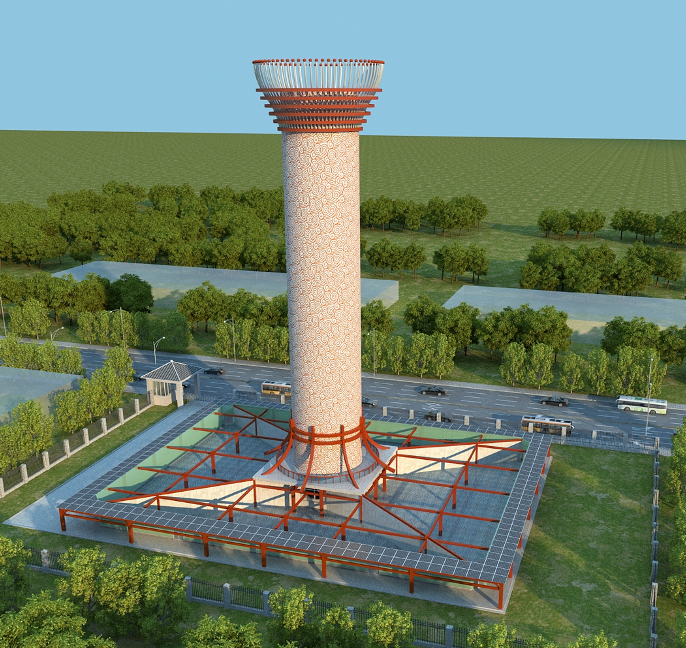Curbing air pollution with purification towers

Above: Researchers in mechanical engineering professor David Pui's Particle Technology Laboratory are developing purification technology to reduce air pollution by filtering out fine particulate matter.
Photo credit: Olivia Hultgren
CSE professor leads international team in building purification towers
April 30, 2020
The air in Delhi, India is thick with smog, ridden with fine particles of sulfates, nitrates, and carbon that millions of residents inhale every day. Imagine a nearly 60-foot tall tower, equipped with a state-of-the-art filtration system, sucking in these particles and pushing out clean, breathable air. It may sound like a pipe dream, but it will soon be a reality for Delhi citizens—thanks to College of Science and Engineering Regents Professor David Pui and his research team in the Department of Mechanical Engineering.
This year, Pui and his colleagues will be working with the Indian Institutes of Technology in both Bombay and Delhi to install one or two “Large Scale Air Purification Towers,” giant structures that clean polluted air within a one-kilometer radius.
“Our research vision is to develop green technology that benefits sustainable environments and enables people and the environment to prosper together,” said Pui, who is also the L.M. Fingerson/TSI Chair in Mechanical Engineering.
“That’s the main reason why my team and I are working so hard, to benefit the well-being of mankind," he said.
According to the Lancet Commission on Pollution and Health, pollution is the largest environmental cause of disease and premature death in the world, causing health conditions ranging from heart disease to neurological disorders to cancer. Pollution was responsible for around 9 million premature deaths in 2015—16 percent of deaths worldwide—6.5 million of which were due to air pollution. Pui says pollution levels in Delhi are so hazardous that they are getting worldwide attention.
On Dec. 11, 2019, Delhi’s level of PM2.5—fine particulate matter generated by combustion and industrial processes, widely hailed as the most dangerous kind of air pollution—reached a high of 504 micrograms per cubic meter. To put that number into perspective, the standard PM2.5 level in the United States is 35, making the pollution levels in Delhi last December about 14 times that of the U.S. 24-hour average.
Pui estimates that if Delhi builds 100 towers over the next few years, his technology could curb the PM2.5 concentration by about 50 percent, giving relief to residents and saving several hundred thousand lives. Although the project had been put on hold for a couple of months due to the threat of COVID-19, Pui and his colleagues are now back on track and ready to implement it for the next smog season.
“If [the pilot test] works, it is possible that more towers will be built,” he said. “Hopefully, we can get 10 built next year, 30 the following year, then 60 the next year.”
First of its kind
Although efforts to reduce pollution have been going on for years, Pui said these towers are “definitely the first large-scale urban air cleaning scheme.” His first model was built in China in 2016 and has since been called the world’s biggest air purifier, cleaning air at a rate of 17 million cubic meters per day.

Pui developed the technology in 2014 with the help of Ph.D. student Qingfeng Cao. Now, his research team also comprises professor emeritus Tom Kuehn, research fellow and alumnus Charles Lo (ME ’70, MS ’73, MBA ’93), and former postdoc Shawn Chen. Pui heads the University of Minnesota’s Particle Technology Laboratory and the Center for Filtration Research, one of the largest industry-funded centers at the University with support from 20 companies.
Pui’s PM2.5 mitigation devices continue to garner attention from countries such as Korea, Japan, Mexico and Thailand, whose tourism-driven Chiang Mai region also suffers from some of the worst pollution in the world.
However, his research team hasn’t stopped there. They’re working on another air purification tower to fight pollution—one that sprays sodium hydroxide-filled water to remove excess carbon dioxide from the air. Pui hopes to implement a CO2 removal system within the next two years.
Everyone’s responsibility
Though effective, Pui said these towers will by no means solve the problems of PM2.5 and carbon dioxide pollution entirely—the end solution hinges on encouraging governments to invest in sustainable technology.
“Climate change is becoming even more important, no matter where you are,” Pui said.
“In the case of India, their population is more packed together, so the towers will be more effective in mitigating PM2.5," he explained. "At least during the next 10-15 years, they can use them to provide relief to residents while they invest in clean energy technology.”
When it comes to the fight against climate change and PM2.5 pollution, Pui said the key is collaboration. He likens the elements of academia, government, and industry to gears turning a wheel. If one gear stops, the wheel stops.
“Academia is good at identifying the sources of pollution and the effects,” Pui explained. “When the effects get bad, the government can step in. In the meantime, industry can develop novel technology that controls power plant and vehicle emissions and reduces the source.”
And the gear that connects all three? The global citizen.
“I tell people that the center gear is you, me, and all the other people,” he said. “We are the global citizens that encourage the three sectors to work together to solve the air pollution problem.”
Story by Olivia Hultgren
If you’d like to support research in the University of Minnesota College of Science and Engineering, visit our CSE Giving website.
